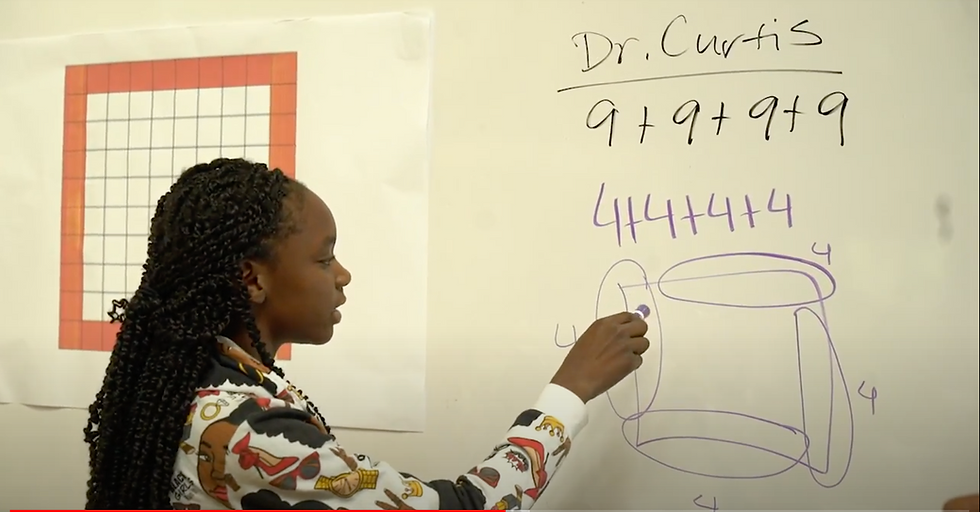Closely Observing Student Thinking
- Yay Math!
- Feb 12, 2020
- 4 min read
Updated: Jun 24, 2020
This blog series documents how our network of schools became interested in lesson study. We have shared how our lesson study teams got started – by creating a shared vision of their hopes and dreams for students, determining a research question and theory of action, narrowing in on a specific content area for their research lesson, and then exploring the mathematical content and selecting a mathematical understanding goal and an equity goal for their research lessons. We have also documented our first four public lesson study events, a 3rd grade lesson on comparing fractions, a 9th grade lesson on lines of best fit, an 8th grade lesson on negative exponents, and a 10th grade lesson on quadratics.

A 7th grade student explains their thinking to the host teacher during a lesson study event.
In the last post we shared details that our research teams have found useful when conducting a public research lesson. One of the tips on their list deserves its own post:
During the lesson we have found the richest data about student learning comes from each team member closely observing and collecting data on the thinking of one focus student and their interactions for the entire lesson.
The team’s learning during a research lesson hinges on what data they notice and collect during the research lesson. If the ultimate goal of any lesson is to advance student understanding, then it is important that the main thing is kept, well, the main thing. Collecting data on how a focus student made sense of the mathematical understanding goal and what impacted the learning process, provides the richest data about what that student learned and how they learned it.
It sounds simple, but closely paying attention to a student’s thinking throughout a lesson is a skill that requires attention and development. As humans we are constantly interpreting what we see through our prior experiences and biases. Our attention can be incredibly selective based on what we expect to see. This can restrict what we notice during a lesson and what information we use to determine our next instructional steps. Personally, I am prone to assuming I know how a student is thinking – or how I think they should be thinking – and it has taken quite a while for me to develop the awareness and tools to check my assumptions and listen carefully to how a student is actually thinking. It is still a skill I’m working on. However, the more I practice, the more I’m in awe of the unique ways that students develop their understanding of math concepts and the better equipped I feel to think about what follow-up questions/lessons/tasks would make the most sense to extend their understanding.
Another factor that inhibits our ability to closely follow student thinking is that, as teachers, we often spend our time focused on all the things we usually focus on when we are teaching a whole class – Is everyone engaged? Is the pace of my lesson right? Are any groups off task? What question should I ask next to deepen students' understanding? These are all important things to notice when teaching, but it means we often miss the nuanced details about how each of our students is developing their understanding of important mathematical concepts during the lesson. Participating in a research lesson as an observing teacher is a rare opportunity to closely observe a focus student’s growing understanding (or misunderstanding) over the course of a lesson, but we need to temporarily shut off the “teaching” side of us that wants to pay attention to everything.
Keeping our biases in check and actively returning our attention to how a focus student is thinking about the mathematics at hand are skills we can develop through participating in research lessons. When we focus on how a student’s understanding evolves over a lesson, we actually deepen our ability to listen more carefully to student thinking even when we’re teaching a whole class. Why? Because we’ve had the opportunity to learn how someone different from us engages in learning math. This broadening of our own understanding about how a student might make sense of mathematical ideas influences what we notice when we’re teaching and what in-the-moment instructional decisions flow from these noticings. We may notice ideas from students who don’t think like us and now be able to highlight them for the class to learn from too.
Ultimately, our research teams hope to cultivate the ability to recognize important mathematical contributions from each student and support students in making connections between each other’s ideas to deepen their mathematical understanding. Closely observing student thinking provides an opportunity to grow these skills.
For educators interested in lesson study we have found that:
Closely observing a focus student’s thinking during a research lesson provides an opportunity for teachers to learn how the student’s mathematical understanding changes over a lesson and what factors supported learning
By becoming students of our students’ thinking our research teams deepen their mathematical knowledge for teaching - the knowledge of how different students make sense of important mathematical concepts.
Up Next: Research Lesson Debrief
Daisy Sharrock works at the Center for Research on Equity and Innovation at the High Tech High Graduate School of Education, and is part of a Student-Centered Learning Research Collaborative-sponsored research team that is currently engaged in the following study: Leveraging the Power of Improvement Networks to Spread Lesson Study. Read more about their current study here. We are grateful to JFF, KnowledgeWorks, and the Student-Centered Learning Research Collaborative and its funders for their support. Learn more at sclresearchcollab.org




Comments